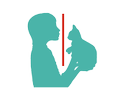
IGE抗体と結合するFELD1

ピュリナは、人とペットの共生社会を目指しています。残念ながら、猫アレルギーの方は愛猫と共に過ごす時間がやむなく減ってしまっているかもしれません。

猫アレルギー:人に統一と猫に共通してみられる課題
アレルギーは、アレルギーを持つ人々の社会的な活動や日常生活に支障をきたすだけでなく、効率と集中力を低下させ、生活の質を損ねます1,2。
猫の飼い主さんは、愛猫に愛情を注ぎ、愛猫を家族の一員ととらえている方がほとんどです。このため、アレルギー専門医のガイドラインが勧めるように、猫と距離を置いて暮らすことには抵抗が生じます2~4。アレルギーが原因で愛猫とのスキンシップが制限されるために、人と動物の絆に影響を与える場合があります。

FEL D 1
ビデオをご覧いただき、主要なネコアレルゲンの詳細をご確認ください
これは、日本語訳のない英語のビデオへのリンクです。
従来のアレルギー治療の限界

猫アレルギーの一般的な対策
- 猫への接触を制限する・避ける3
- アレルギー治療薬による対症療法9
- 免疫療法で減感作する3,10
- 空間の清掃2,3,11
これらにはそれぞれ限界があります。
アレルゲン負荷の減少:アレルギー管理の第一目標
アレルギーのある人は、2つ以上のアレルゲンに対して感作されていることが多く、アレルギーの閾値は人によって異なり、この閾値を超えるとアレルギー症状が発現します。1つのアレルゲンに曝露されただけでは問題にはならず、同時に数種類のアレルゲンに曝露されると、累積効果(アレルゲン負荷総量)により、その人の閾値を超えることになり、アレルギー反応を誘発する場合もあります12。
例えば、複数の種類の花粉に対するアレルギーを持つ人で、アレルゲンとなる花粉が1種類しか存在しない場合には、症状がでないこともありますが、春になり他の花粉が増えアレルゲン負荷が増加すると、症状が発現する場合があります。
もし1種類以上のアレルゲンへの曝露を避ける、もしくは減らすことができるなら、アレルゲンに対する曝露の累積効果を個人の許容量以下に抑え、アレルギーの症状を改善、あるいは症状の発現を防止できる可能性があります12。累積効果をアレルギー閾値未満に抑えられるか、またそれがどれだけの時間維持できるかによってアレルギー患者に対する効果にはばらつきが生じます。


猫アレルギーを管理するピュリナの革新的なアプローチ
Fel d 1アレルゲン負荷を低下させるための新しいアプローチは、抗原抗体反応を利用して猫が産生したFel d 1を環境中に拡散する前に不活性化します。抗Fel d 1 IgY抗体を含む卵由来成分を配合したフードを猫に与えると、猫の唾液や毛に存在する活性Fel d 1(IgEに結合する能力のある Fel d 1で、感作済みの人ではアレルギー反応を誘発します)が劇的に減少します。これにより、環境内の活性Fel d 1量が最終的に減少し、アレルギーのある人の症状が軽減します14~16。
関連コンテンツ
詳しく知る
1. Leynaert, B., Neukirch, C., Liard, R., Bousquet, J. & Neukirch, F. (2000). Quality of life in allergic rhinitis and asthma: A population-based study of young adults. American Journal of Respiratory and Critical Care Medicine, 162, 1391-1396.
2. Cosme-Blanco, W., Arce-Ayala, Y., Malinow, I. & Nazario, S. (2018). Primary and secondary environmental control measures for allergic diseases. In M. Mahmoudi (Ed.), Allergy and Asthma (pp. 1-36). Switzerland: Springer Nature. doi: 10.1007/978-3-319-58726-4_36-1
3. Dávila, I., Dominguez-Ortega, J., Navarro-Pulido, A., Alonso, A., Antolin-Amerigo, D., Gonzalez-Mancebo, E., Martin-Garcia, C., Nunez-Acevedo, B., Prior, N., …Torrecillas, M. (2018). Consensus document on dog and cat allergy. Allergy, 73(6), 1206-1222. doi: 10.1111/all.13391
4. Salo, P.M., Cohn, R.D., & Zeldin, D.C. (2018). Bedroom allergen exposure beyond house dust mites. Current Allergy and Asthma Reports, 18, 52. doi: 10.1007/s11882-018-0805-7
5. Bonnet, B., Messaoudi, K., Jacomet, F., Michaud, E. Fauquert, J.L., Caillaud, D., & Evrard, B. (2018). An update on molecular cat allergens: Fel d 1 and what else? Chapter 1: Fel d 1, the major cat allergen. Allergy, Asthma and Clinical Immunology, 14, 14. doi: 10.1186/s13223-018-0239-8
6. Butt, A., Rashid, D., & Lockey, R.F. (2012). Do hypoallergenic dogs and cats exist? Annals of Allergy, Asthma & Immunology, 108, 74-76. doi: 10.1016/j.anai.2011.12.005
7. Bastien, B., Gardner, C. & Satyaraj, E. Influence of time and phenotype on salivary Fel d 1 in domestic shorthair cats. In press, Journal of Feline Medicine and Surgery.
8. Kelly, S.M., Karsh, J., Marcelo, J., Boeckh, D., Stepner, N., Litt, D.,...Yang, W.H. (2018). Fel d 1 and Fel d4 levels in cat fur, saliva and urine. Journal of Allergy and Clinical Immunology, 142, 1990-1992.e3. doi: 10.1016/j.jaci.20107.033
9. Brown, L.C. & Slavin, R.G. (2005). Improving quality of life in patients with allergic rhinitis: The pharmacist’s role. Pharmacy Times. Retrieved from https://www.pharmacytimes.com/publications/issue/2005/2005-06/2005-06-9606 [accessed March 1, 2019] .
10. Mueller, R.S., Jensen-Jarolim, E., Roth-Walter, F., Marti, E., Janda, J., Seida, A.A. & DeBoer, D. (2018). Allergen immunotherapy in people, dogs, cats and horses – differences, similarities and research needs. Allergy, 73, 1989-1999. doi: 10.1111/all.13464
11. Björnsdottir, U.S., Jakobinudottir, S., Runarsdottir, V. & Juliusson S. (2003). The effect of reducing levels of cat allergen (Fel d 1) on clinical symptoms in patients with cat allergy. Annals of Allergy, Asthma and Immunology, 91, 189-194.
12. Wickman, M., Egmar, A.C., Emenius, G., Almqvist, C., Berglind, N., Larsson, P. & Van Hage-Hamsten, M. (1999). Fel d 1 and Can f1 in settled dust and airborne Fel d 1 in allergen avoidance day-care centres for atopic children in relation to number of pet-owners, ventilation and general cleaning. Clinical and Experimental Allergy, 29, 626-632.
13. Ciprandi, G., Alesina, R., Ariano, R., Aurnia, P., Borrelli, P., Cadario, G.,…Frati, F. (2008). Characteristics of patients with allergic polysensitization: the polismail study. European Annals of Allergy and Clinical Immunology, 40, 77-83.
14. Satyaraj, E., Li, Q., Sun, P. & Sherrill, S. Anti-Fel d 1 immunoglobulin Y antibody-containing egg ingredient lowers allergen levels in cat saliva. Submitted, Journal of Feline Medicine and Surgery.
15. Satyaraj, E., Gardner, C., Filipi, I., Cramer, K. & Sherrill, S. (2019). Reduction of active Fel d 1 from cats using an antiFel d 1 egg IgY antibody. Immunity, Inflammation & Disease. Advance online publication. doi: 10.1002/iid3.244
16. Wedner, H.J., Mantia, T., Satyaraj, E., Gardner, C., Al-Hammadi, N. & Sherrill, S. Feeding cats egg product with anti-Fel d 1 antibodies decreases environmental Fel d 1 and allergic response. Submitted, Journal of Allergy and Clinical Immunology.


